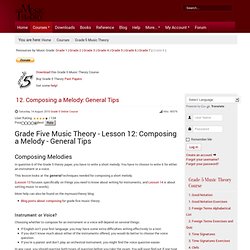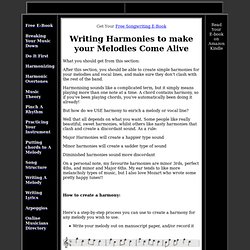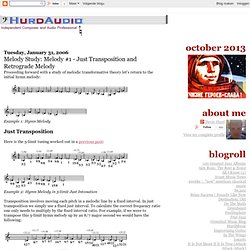

14. Composing a Melody for Voice. Saturday, 14 August 2010 Grade 5 Online Course Hits: 20069 The Question In the Grade 5 Theory of Music exam, you’ll be given the first two lines of text, usually taken from poetry, and two blank staves.

The instructions will ask you to write a complete melody for solo voice to fit the words of the text: you can choose whichever voice (soprano, alto, tenor or bass) you prefer. You don’t have to write which voice you’ve chosen, but you will have to keep the melody within the normal range of one voice, and use the appropriate clefs (see "Lesson 9: Writing for Voices – SATB”, for more about this). 12. Composing a Melody: General Tips. Saturday, 14 August 2010 Grade 5 Online Course Hits: 90376 Composing Melodies In question 6 of the Grade 5 theory paper, you have to write a short melody.

You have to choose to write it for either an instrument or a voice. This lesson looks at the general techniques needed for composing a short melody. (Lesson 13 focuses specifically on things you need to know about writing for instruments, and Lesson 14 is about setting music to words). More help can also be found on the mymusictheory blog: Blog posts about composing for grade five music theory Instrument or Voice? Choosing whether to compose for an instrument or a voice will depend on several things: If English isn’t your first language, you may have some extra difficulties writing effectively to a text. In any case, you should practise both types of question before you take the exam. Writing for an Instrument You’ll be given the first two bars of a melody, with the key and time signature. Here's an example question: Songwriting Tips - Learn The Easy Way To Write Harmony. Get Your Free Songwriting E-Book What you should get from this section: After this section, you should be able to create simple harmonies for your melodies and vocal lines, and make sure they don’t clash with the rest of the band.

Harmonising sounds like a complicated term, but it simply means playing more than one note at a time. A chord contains harmony, so if you’ve been playing chords, you’ve automatically been doing it already! But how do we USE harmony to enrich a melody or vocal line? Www.clt.astate.edu/tcrist/theory2/phrasesperiods.pdf. Ch_10_cad_phr_per.pdf. Lesson 22- Cadences. Www.music.sc.edu/fs/bain/vc/musc116/pub/ref/mf/TheDoublePeriod.pdf. My Music Theory Blog. Melody Study: Melody #1 - Just Transposition and Retrograde Melody. Proceeding forward with a study of melodic transformative theory let's return to the initial hymn melody: Example 1: Hymn Melody Just Transposition Here is the 5-limit tuning worked out in a previous post: Example 2: Hymn Melody in 5-limit Just Intonation Transposition involves moving each pitch in a melodic line by a fixed interval.

Example 3: Hymn Melody transposed by 8/7. Now this 5-limit melodic line is shifted into a 7-limit space, even though the melodic line itself adheres to a 5-limit sound. Retrograde Melody Another relatively straight forward function for melodic transformation is retrograde melody. Example 4: Hymn Melody - Retrograde. A couple of variations on the retrograde function to consider involve separating the pitch sequence and rhythm and reversing them independently. Example 5: Hymn Melody - Pitch order Retrograde. Counterpoint. General principles[edit] It is hard to write a beautiful song.

It is harder to write several individually beautiful songs that, when sung simultaneously, sound as a more beautiful polyphonic whole. The internal structures that create each of the voices separately must contribute to the emergent structure of the polyphony, which in turn must reinforce and comment on the structures of the individual voices. The way that is accomplished in detail is...'counterpoint'.[1] In the modern period, polytonality and atonality were introduced. Development[edit] Species counterpoint[edit]